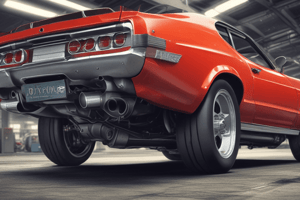Podcast
Questions and Answers
Match the following car parts with their functions:
Match the following car parts with their functions:
Engine = Power generation for the vehicle Brakes = Slowing down and stopping the car Exhaust system = Removing harmful gases from the engine Cooling system = Regulating engine temperature
Match the following car maintenance tasks with the parts they involve:
Match the following car maintenance tasks with the parts they involve:
Tire rotations = Involves rotating tires to ensure even wear Timing belts = Part of the engine that synchronizes camshaft and crankshaft movement Spark plugs = Ignites air-fuel mixture in the engine cylinders Wheel alignments = Adjusting angles of wheels to manufacturer's specifications
Match the following car parts with their replacement frequency:
Match the following car parts with their replacement frequency:
Batteries = Replaced periodically due to degradation over time Windshield wipers = Usually replaced annually for optimal performance Light bulbs = Replaced when they burn out Filters (e.g., air and oil filters) = Regularly replaced as part of maintenance
Match the following terms with their definitions in the context of replacement parts:
Match the following terms with their definitions in the context of replacement parts:
Match the car part with its recommended periodic check:
Match the car part with its recommended periodic check:
Match the car part with the DIY monitoring tip:
Match the car part with the DIY monitoring tip:
Match the car part with its potential cost implication:
Match the car part with its potential cost implication:
Match the car part with the type of insurance coverage it may be eligible for:
Match the car part with the type of insurance coverage it may be eligible for:
Match the car part with its significance in predictive maintenance techniques:
Match the car part with its significance in predictive maintenance techniques:
Match the car part with its importance in professional maintenance schedules:
Match the car part with its importance in professional maintenance schedules:
Flashcards are hidden until you start studying
Study Notes
Chapter 1: Introduction to Car Parts
In the realm of vehicle ownership, understanding the importance of maintaining your car's components is vital. Regular inspections and care can help prevent significant damage and costly repairs down the line. This chapter will delve into the essential car parts that require attention and how they contribute to the overall functionality of a vehicle.
Section 1: Essential Parts for Vehicle Functionality
There are several crucial components within a car that need regular checks or replacements over time. Each serves a purpose contributing to the proper functioning of the vehicle. Some of these key elements include engines, transmissions, steering mechanisms, brakes, suspension systems, exhaust systems, lighting systems, and cooling systems.
Section 2: Commonly Replaced Parts
While some parts may require more frequent replacement due to wear and tear, others might be replaced less often. Examples of commonly swapped parts include batteries, filters (such as air and oil filters), windshield wipers, light bulbs, tire rotations, wheel alignments, timing belts, and spark plugs.
Section 3: OEM vs Aftermarket Parts
When it comes to choosing replacement parts for your car, there are two main options: Original Equipment Manufacturer (OEM) or aftermarket products. OEM parts are made by the original manufacturer and come with a guarantee, ensuring compatibility with your specific vehicle. Aftermarket alternatives, on the other hand, offer varying degrees of quality and compatibility, making them potentially less reliable.
Chapter 2: Importance of Consistent Inspections
Regular inspections play a significant role in identifying potential issues before they become serious problems. This allows you to address minor concerns promptly instead of waiting until major breakdowns occur. Key areas requiring periodic checks include brakes, tires, engine oil, transmission fluid, battery health, windshield wiper blades, headlights, and exhaust systems.
Section 1: Professional Maintenance Schedules
Manufacturers typically recommend specific maintenance schedules tailored to individual models. Following these guidelines ensures optimal performance and longevity of your vehicle. However, some factors like driving habits, road conditions, and climate variations may affect the frequency of needed inspections.
Section 2: DIY Monitoring Tips
Performing routine checks yourself can help maintain your vehicle efficiently and save money in the long run. Be sure to consult your owner's manual for recommended maintenance intervals and always prioritize safety when dealing with mechanical components.
Chapter 3: Cost Implications & Planning
Understanding the potential costs associated with vehicle maintenance is crucial for budgeting purposes. While certain parts might require immediate replacement upon failure, others may last for years without issue. Additionally, investing in high-quality OEM components could lead to fewer future expenses related to faulty replacements.
Section 1: Forecasting Expenses
Predictive vehicle maintenance techniques employ data analytics to identify patterns and potential issues before they escalate into critical failures. This allows drivers to plan ahead financially, preparing for upcoming repairs or replacements when necessary.
Section 2: Insurance Coverage & Extended Warranties
Some insurance policies offer coverage for car parts and repairs due to normal wear and tear or certain accidents. Similarly, extended warranties provide additional protection against unexpected breakdowns during the warranty period.
Studying That Suits You
Use AI to generate personalized quizzes and flashcards to suit your learning preferences.



